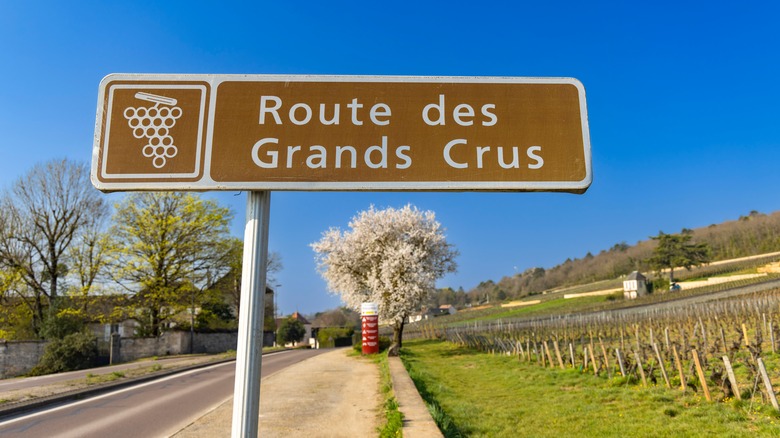Decoding Wine Labels: What Grand Cru Can Tell You About Its Origin
Picking up a bottle of wine can feel a bit intimidating, particularly if the label is written entirely in French. The good news is that you can learn to decode that wine label by understanding what exactly the terms on the label mean, which (yes) vary depending on where the wine is from. For example, "Grand Cru" means one thing when a wine is from Champagne, something slightly different when it's from Burgundy, and yet another meaning for Bordeaux wines.
Here's the best news: Grand Cru means the wine should be good. In all three locations — Champagne, Burgundy, and Bordeaux — Grand Cru means the wine comes from either a place or a producer that's highly regarded and legally defined as one of the best in the region. While Grand Cru wines typically carry higher prices than wines that lack the distinction, they are, in general, the best of what a region has to offer. If you're looking for a special occasion Champagne, Burgundy, or Bordeaux, Grand Cru denotes a wine of high quality, though it may cost you dearly.
What does Grand Cru mean in Champagne?
"Cru" in French simply means "growth," a term that in winemaking refers to a superior site for either growing grapes or making wine. In Champagne, it is villages or communes that are classified according to the cru system. There are 17 villages designated as Grand Cru, and only if a Champagne contains 100% Grand Cru juice, can it carry that designation on the label. The villages are the names that get Champagne enthusiasts seriously excited: Ambonnay, Ay, Beaumont sur Vesle, Bouzy, Chouilly, Le Mesnil-sur-Oger, Louvois, Oger, Oiry, Sillery, Verzenay, and Verzy, to name a few. While you can track down Grand Cru Champagne for less than $100, many bottles run well north of that.
A further 43 villages are designated Premier Cru, second in quality to Grand Cru, and the other 300 or so villages are simply classified as Champagne. Interestingly, historically, the cru system in Champagne determined the price growers were paid for grapes at harvest. The Comité Interprofessionnel des Vins de Champagne established a price per kilo each year, and Grand Cru growers received 100% of the annual price, while Premier Cru sites earned 90-99% of the price, depending on location, and growers outside the top cru designations received 80-89% of that price, again, depending on the location. Though the Comité no longer fixes prices for each year's harvest, the Grand Cru and Premier Cru designations are still used by producers of the Champagne region.
What does Grand Cru mean in Burgundy?
In Champagne, Grand and Premier Cru refer to villages, but those terms are reserved for specific vineyards in Burgundy. There are four levels of classification in Burgundy: Grand Cru, Premier Cru (often abbreviated on labels at 1er Cru), Villages, and just plain old Bourgogne Rouge or Blanc.
Grand Cru, which accounts for roughly 1% of all Burgundy vineyards, includes wines made from 33 vineyards, the name of which will appear on the bottle. Grand Cru vineyards in Burgundy include Grands-Echézeaux, Charmes-Chambertin, Montrachet, La Tâche, and Romanée-Conti. Some of these tiny vineyards are shared among several owners, all of whom prize the fruit they produce. In fact, only five Grand Cru vineyards in all of Burgundy are monopoles, meaning they have a single owner.
Wines from these appellations command frankly obscene prices, but considering the fact that La Tâche vineyard measures a scant 6 hectares in size, the price tag for a bottle of Domaine de La Romanée-Conti from its monopole La Tâche vineyard might seem like a relative bargain at more than $7,000, if you're lucky enough to find one. Of course, not all Grand Cru Burgundies are quite so expensive, and there are also values to be found among the 640 1er Cru vineyards in the region, sites like Vosne-Romanée, Gevrey-Chambertin, and Meursault.
What does Grand Cru mean in Bordeaux
And that brings us to Bordeaux, which plays by an entirely different set of labyrinthine rules. It's safe to say that perhaps no other region has fought over its classification system more than Bordeaux, and calling the results confusing is no understatement. One important difference between Bordeaux and both Champagne and Burgundy is that the classification system refers to the wine producer, or chateau, rather than to the vineyard or village where the grapes are grown.
Formally classifying Bordeaux began in 1855, when Emperor Napoleon II ordered each wine region to develop classification systems. The result in Bordeaux for red wines, referred to as the "Grand Cru Classés en 1855" resulted in four chateaux being designated as Premiers Crus, the highest distinction in Bordeaux: Haut-Brion, Latour, Lafite-Rothschild, and Margaux. In 1973, Chateau Mouton-Rothschild was promoted to a Premier Cru, notable because no other chateau has been elevated since. These five chateaux are commonly referred to as the First Growths, and the wines, often sold as futures, meaning they're traded before they're released, commonly sell for more than $1000 per bottle.
The problem with the 1855 classification is that it only accounts for a portion of the wines Bordeaux produces. In all, Bordeaux contains roughly 6,000 chateaux, a mere 61 of which are classified in the 1855 Grand Cru Classés.
What about the rest of Bordeaux?
In all, Bordeaux contains 38 sub-regions and 57 appellations, most of which are outside the area classified in 1855. A little geography: there are two important rivers in Bordeaux that are used to delineate sub-appellations, the Gironde and the Dordogne. The 1855 Grand Cru Classés only classified the Médoc appellation, on the left bank of the Gironde, along with Chateau Haut-Brion in the Graves region just south of the Médoc.
There's amazing wine made on the right bank as well, though, so other classifications were created. St. Émilion has its own classification, and its top chateaux are the Premier Grand Cru Classe A chateaux of Angelus, Ausone, Cheval Blanc, and Pavie, wines that often sell for even more than the left bank First Growths. Graves also has its own classification system, which means that Chateau Haut-Brion is classified under two separate systems. And Pomerol, legendary for its Merlot-based wines like Petrus, has no classified chateaux at all.
So when you encounter Grand Cru on a label of French wine, it does, indeed, denote a wine of exceptional quality, whether that means it comes from a specific village in Champagne, a vineyard in Burgundy, or a chateau in Bordeaux. What gets confusing are the details, like the fact that Grand Cru is the highest classification in Champagne and Burgundy, above Premier Cru, while chateaux in most of Bordeaux carry the Premier Cru designation as their highest distinction.




